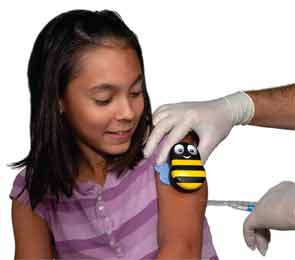
One early morning in the summer of 2004, as she was driving home from an overnight shift at the hospital, Amy Baxter, MD, came up with a simple—but, she thought, powerful—idea.
Her son had just had a horrible experience getting a shot. But did the age-old tradition of terrified, crying children being tugged into the pediatrician’s office really have to be the tradition?
What if vibration and cold were applied near the injection site to, in essence, snuff out much of the pain of the needle?
Panacea for Needle Phobia
Dr. Baxter worked on the idea for a while and soon, Buzzy was born. It’s a contraption that applies a high-frequency vibration sensation near the injection site, along with ice, that cuts down the amount of pain by about 50% in children. Buzzy was originally made in the form of a happy, cartoon bee to appeal to children, but Baxter soon found that it works even better for adults, including rheumatology patients needing weekly injections: In adults, it reduces the pain by about 80%, the company’s research has found.
She was able to develop and manufacture Buzzy with a $1-million federal Small Business Innovation Research grant. The first Buzzy, which costs $39.95, was sold in 2009. And there are now 22,000 users, says Baxter, a pediatric pain physician and researcher.
It is sold mostly to patients and to hospitals, which use it mostly for IV access. But among specific diseases, rheumatology ranks near the top of the list, Baxter says.
“Buzzy has unquestionably gotten people over the fear of needles,” she says. “My kids don’t even ask anymore, ‘Am I going to get a shot?’ They just say, ‘Did you bring Buzzy?’ ”
A 2012 survey study out of the University of Toronto found that 24% of parents and 63% of children report a fear of needles. And that fear was the main reason for noncompliance with immunization in 7% of parents and 8% of children, the study found. The authors suggested a wider education about interventions that ease pain during injections.1
“We’re raising a generation of needle-phobic kids, and once they’re old enough to drive themselves to the doctor, they’re not going to do it,” Dr. Baxter says. “Then we’re going to have a real problem with noncompliance.”
At first, three-quarters of Buzzy’s users were kids. Now, about two-thirds of the users are adults, she says. “A plain black version is now available for older users.”

A Boon for Rheumatology Patients
Tracy Lovell, MD, a rheumatologist at the Northeast Georgia Diagnostic Clinic in Gainesville, Ga., says she suggests Buzzy to patients when they balk at giving themselves injectable medications. About 10 of her patients use the device, she says.
She says it can be particularly important in psoriatic arthritis patients who have failed infliximab (Remicade), since the only other good options in severe cases are injectable drugs like etanercept (Enbrel) and adalimumab (Humira). One patient with psoriatic arthritis flat-out refused to take an injectable until he saw how well Buzzy worked, essentially knocking out the pain completely.
“This is a good modality to make the patient more comfortable with accepting the therapy and also be comfortable with giving it to themselves,” Dr. Lovell says.
Buzzy works because of gate control, in which the sensations of the vibration and the cold of an icepack crowd out the sharpness of the needle and the burning feeling of medication being injected. The different nerves transmitting the sensation of vibration, cold, and the burning of the injection share a final common pathway—and, with the overstimulation with vibration and the cold, the sharpness of the injection is thwarted.
Dr. Baxter used the example of getting a burn on your hand and running it under cold water. “Immediately, the sharpness of pain is overwhelmed by the coldness and vibration,” she says. “That’s how Buzzy works.”
Adults are also helped by descending inhibitory control, a phenomenon not seen in young children. Dr. Baxter describes it as a powerful sensation—like putting your hand in a bucket of ice water—taking up so much “bandwidth” that you can tolerate more pain elsewhere. This coping device is developed as we age, and is also why adults can tolerate somewhat unpleasant tastes, like bitterness, more than children. Buzzy can be strapped on for shots in the arm, placed between the site of the injection and the brain. It can also be held in the palm and applied to the skin. It is typically held to the area for a short time before the injection to desensitize the nerves.
The vibrating mechanism in Buzzy is a flywheel motor with a piece of metal at the end of the motor that is off balance, so that when the motor spins the metal piece shakes and causes a high-frequency vibration. The motor is angled so that its energy is optimally directed to the nerves.
Dr. Baxter has gotten feedback from a woman whose 79-year-old father was so averse to needles that he almost stopped his dialysis. With Buzzy, he continued the treatment. She says she has also heard from a woman who said the experience of giving shots to her daughter, who needs regular injections for an illness, went from a three-hour ordeal full of tantrums to a five-minute activity.
Carroll Turner, who runs a life sciences incubator and is a patient of Dr. Lovell’s, says he used to routinely put off taking his weekly Enbrel injection because of the pain of the injection.
Sometimes, “I just wasn’t up to it” or “just didn’t feel like it,” he says.
Since he started using Buzzy about two years ago, he’s been taking the injections at the same time every week.
“I don’t ever miss an injection now,” he says.
He rated the pain of the injection a 4 out of 10, with 10 being the worst imaginable pain, before Buzzy. Now, the pain is a non-issue, he says.
“With the Buzzy, there’s just no pain,” he says. “It’s not as unpleasant so you don’t think about it and you just go ahead and do it,” he says. “It takes the anxiety away.”
Thomas Collins is a freelance medical writer based in Florida.

